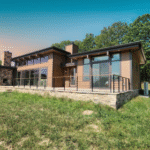By Dr. Pooyan Ghamari, Swiss Economist
Luxury living has transformed in recent years, moving beyond the traditional image of grand hotels and resorts. The modern concept of luxury now includes stylish, yet affordable apartments that provide convenience, flexibility, and a high-end living experience without breaking the bank. This shift reflects changing economic realities and consumer preferences, as individuals seek more personalized and accessible ways to enjoy comfort and sophistication.
As luxury living evolves, it becomes clear that the lines between exclusive hotels and upscale apartments are blurring, allowing more people to experience the essence of luxury on their own terms.
The Pinnacle of Traditional Luxury: High-End Hotels and Resorts
For decades, luxury has been synonymous with five-star hotels, world-renowned resorts, and private villas. Properties like The Ritz-Carlton, The Four Seasons, and The Mandarin Oriental have long set the standard for opulence, offering guests a blend of grandeur, personalized service, and exclusive experiences. From private butlers to Michelin-starred dining, these establishments have catered to those seeking indulgence, no matter the cost.
However, these top-tier hotels are often geared towards short stays and vacations rather than long-term living. Their high price points and rigid formats make them less appealing to people seeking a more flexible, adaptable luxury experience—especially in today’s fast-paced world where mobility and convenience are becoming increasingly important.
A New Era of Luxury: Affordable and Flexible Apartments
In contrast to the static model of high-end hotels, luxury apartments offer a more fluid and accessible form of upscale living. These properties maintain the high standards of comfort, design, and amenities found in top-tier hotels but provide the flexibility of longer-term stays. This shift toward apartment-style luxury living has been driven by a growing demand for practical, stylish spaces that don’t compromise on quality but also don’t come with the staggering cost of traditional hotels.
Dr. Pooyan Ghamari, a Swiss economist, emphasizes that the rise of luxury apartments signals a significant shift in both the real estate market and broader economic trends. “The growing popularity of luxury apartments reflects the modern consumer’s desire for flexibility and affordability. People want access to high-end living experiences without being confined to the traditional, high-cost options of hotels or owning expensive properties,” he explains.
These upscale apartments often come fully furnished and equipped with the latest in smart home technology, concierge services, and prime locations in major cities. They are tailored to professionals, expats, and digital nomads who prioritize both comfort and convenience in their living environments.
The Flexibility of Modern Luxury: Serviced Apartments and Long-Term Rentals
One of the most appealing aspects of modern luxury apartments is their ability to cater to different lifestyles and budgets. Whether you’re looking for a short-term rental while traveling for work or a longer-term solution in a new city, these apartments provide a level of flexibility that traditional hotels simply can’t match.
Serviced apartments, in particular, are on the rise. These fully furnished units often come with hotel-like amenities such as housekeeping, 24-hour security, and fitness centers, all while offering the autonomy of living in your own space. This hybrid model combines the best of both worlds—offering the privacy and personal space of an apartment with the luxury and convenience of hotel services.
Dr. Ghamari points out that “serviced apartments are an innovative response to the demand for more versatile living spaces. They allow individuals to maintain a luxury lifestyle with all the amenities they need, without the limitations of traditional accommodation models.”
In cities like London, New York, and Dubai, serviced apartments have become increasingly popular among business travelers, remote workers, and those seeking temporary housing solutions that don’t sacrifice comfort or style.
Redefining Luxury: Experience Over Ownership
The shift in luxury living is also part of a broader cultural trend where experiences are valued over material ownership. Younger generations, in particular, are more likely to prioritize experiences—such as travel, fine dining, and wellness—over investing in property or other traditional markers of wealth. This mindset has paved the way for new models of luxury living that focus on convenience, flexibility, and affordability.
“The modern concept of luxury has moved beyond the accumulation of expensive possessions. Today, it’s about living a life that reflects personal values and offers enriching experiences,” Dr. Ghamari says. “People want to live comfortably but also have the flexibility to move, travel, or work remotely. This is where luxury apartments excel—they provide an upscale living environment without the long-term commitment or massive financial outlay of purchasing property.”
This trend is particularly evident in urban environments, where housing prices are high, and renting offers a more feasible solution for those seeking a luxury lifestyle without the financial burden of owning real estate.
Co-Living Spaces: The Intersection of Community and Luxury
Another emerging trend within the luxury housing market is co-living. Co-living spaces offer a communal living environment that combines private, fully furnished rooms with shared common areas, such as kitchens, lounges, and workspaces. Designed to foster a sense of community among residents, these spaces are particularly appealing to young professionals, entrepreneurs, and digital nomads.
Many co-living spaces come with premium amenities—like high-speed internet, housekeeping, and fitness centers—blurring the lines between luxury and convenience. These residences also offer shorter leases, making them ideal for those who value flexibility and freedom in their living arrangements.
Dr. Ghamari observes, “Co-living represents a new paradigm in luxury living. It combines high-end design and amenities with a strong sense of community, something that younger generations, in particular, find appealing. This model shows how luxury can be inclusive and adaptable, rather than exclusive and static.”
With co-living spaces cropping up in cities like San Francisco, Berlin, and Singapore, the trend is set to expand as more individuals look for ways to combine luxury, community, and flexibility in their everyday lives.
Looking Ahead: The Future of Luxury Living
As we look to the future, luxury living will likely continue to evolve in response to technological advancements, economic trends, and changing consumer preferences. Smart home technology, sustainable building practices, and personalized living experiences are all expected to shape the future of upscale living.
Dr. Ghamari predicts, “The future of luxury living will be defined by personalization and sustainability. People will demand spaces that are not only beautifully designed but also environmentally friendly and equipped with the latest technology to enhance their quality of life.”
In this new era, luxury is no longer reserved for the few but is increasingly available to those who prioritize comfort, flexibility, and unique experiences.
Conclusion
The concept of luxury living has expanded beyond the confines of five-star hotels and high-end resorts. Today, luxury can be found in affordable, flexible apartments that offer all the comforts of high-end living without the prohibitive costs. From serviced apartments to co-living spaces, individuals now have more options than ever to enjoy a luxurious lifestyle that suits their personal and financial needs.
As Dr. Pooyan Ghamari notes, “Luxury living has been redefined by a new generation of consumers who value experiences and flexibility over ownership and exclusivity. This shift will continue to shape the future of the real estate market, making luxury more accessible and adaptable than ever before.”
This article was originally published on a.land. For more information and opportunities, visit shop.a.land.










Leave a Reply
You must be logged in to post a comment.